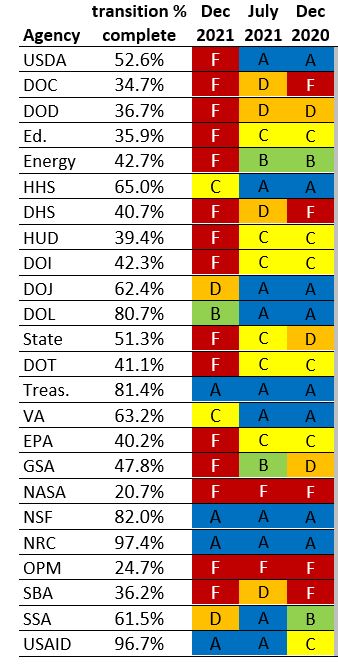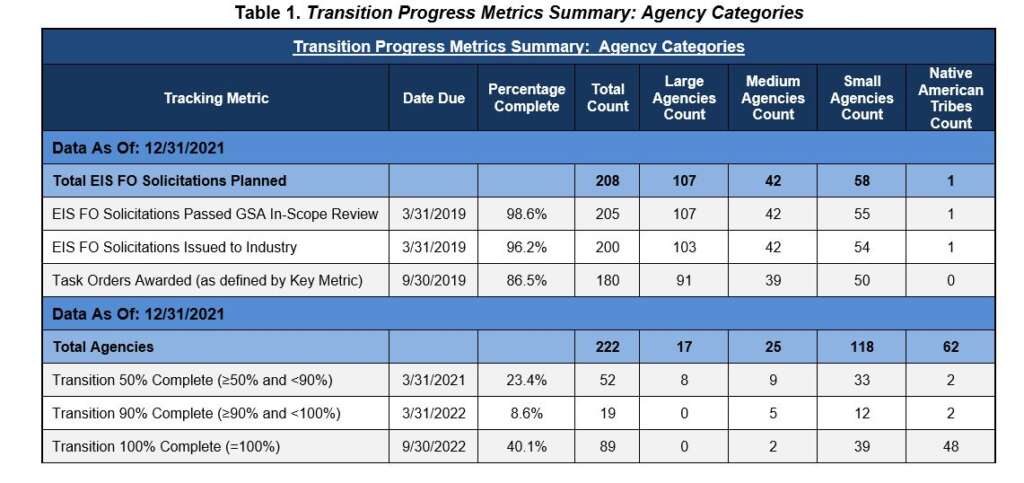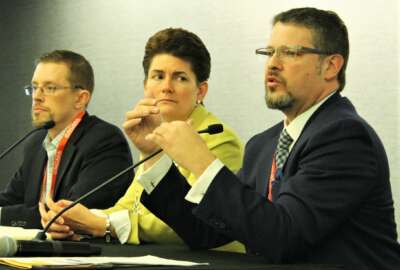First Look
Transition to new telecom contract hits wall, forcing GSA to extend timetable
GSA is extending the continuity of services clause for Networx, WITS 3 and the local service contracts for a year that will allow agencies and vendors time to...
Best listening experience is on Chrome, Firefox or Safari. Subscribe to Federal Drive’s daily audio interviews on Apple Podcasts or PodcastOne.
If the 15 red blocks that dominated the detailed version of the latest Federal IT Acquisition Reform Act (FITARA) scorecard didn’t tell you the transition to the new telecommunications acquisition vehicle wasn’t going as well as expected, then you will be surprised by the General Services Administration’s recent decision. But you will be one of the few.

Most observers in industry and in government have recognized for some time that agencies were struggling to move to the Enterprise Infrastructure Solutions (EIS) program similarly to the way they struggled to move to Networx and to FTS 2001.
The FITARA scorecard just reminded us that most agencies were not going to meet the March deadline of transitioning at least 90% of all services off of Networx and onto EIS. But it’s more than just the March deadline. The September deadline of moving 100% of all services to EIS also was in real doubt.
So to many, GSA’s recent decision to extend the current telecommunications contracts — specifically the continuity of services (CoS) piece — by another year was inevitable.
As one federal executive said, between the multiple continuing resolutions, changes to how agencies are expected to pay for services under EIS, the impact of the pandemic and the protracted contract award timeline, the cards were stacked against GSA and EIS.
“I think we are staying on schedule as much as we can,” said the executive, who requested anonymity because they didn’t get permission to speak to the press. “We should [be] responsible for our plan and for protecting our mission areas. I don’t blame GSA in any of this. The real challenge is asking agencies to do too much with the amount of funding they have. We have to pay for [a] full year of telephone service on a contract that we don’t have the funding for. It’s like asking you to pay for your electricity bill each month at the beginning of the month versus the following month like you do now under the utility model.”
The source said the change to how agencies must pay for telecommunication services turned out to be a bigger obstacle than anyone initially imagined. The source said basically GSA went from a utility model where agencies paid for services after they used them, like your home’s electric or gas bill, to having to pay for services upfront. This requires estimating the amount of services you may use and then having the money to pay for them.
“If I have a new service order for 12 months or if I’m renewing my existing service order for 12 months, I don’t have money for both. I only have a portion of that funding so I can’t fund the new contract beyond the date of the CR,” the executive said. “That puts us all sideways. Now some agencies may ignore it and some don’t. But the fact is not having money to move to the new contract is causing additional delays.”
The delays agencies are facing and the challenges associated with the acquisition timeline and CRs forced GSA to finally relent to the need for an extension, something many in industry thought was inescapable. GSA sent a memo to agencies last week letting transition leaders and others know about their decision to give them more time to transition from the Networx contract. GSA said the risk to agencies who could lose services when the current set of contracts expire in 2023, including Networx, and Washington Interagency Telecommunications System (WITS) 3 and Local Service, was too much to bear and the continuity of service contracts will be extended to May 2024.
“In order to take advantage of the CoS period, agencies must sign a Memorandum of Understanding (MOU) with GSA,” wrote Allen Hill, deputy assistant commissioner in GSA’s Office of IT Category, in a memo to agency leaders, which Federal News Network obtained. “Invoking the CoS clause is different from extending the contracts. Networx, WITS3 and the Local Service contracts will still expire on May 31, 2023. No services can be added or modified during the CoS period, and any services that remain at the end of the period will be disconnected.”
At the next interagency meeting on March 3, GSA said it will provide additional information about the implementation of the CoS clause.
A GSA official told Federal News Network that the extension of the continuity of services clause for Networx, WITS 3 and the local service contracts will “allow agencies and vendors time to sunset services on the expired contracts.”
“As painful as possible”
GSA first made the announcement at a recent meeting of the Federal Chief Information Officer’s Council, Federal News Network learned.
One government source said no one was shocked by the announcement at the meeting.
“If you want that extension your secretary will need to ask permission from the Office of Management and Budget. They want to make it as painful as possible,” the source said. “Contracting has been the biggest challenge. It took a long time to award contracts and that is how we got behind the eight-ball on the transition.”
A perfect example of this is FEMA awarded AT&T four EIS contracts, worth a total of $167 million over five years to modernize their voice and data systems, their wireless local area network capabilities, the contact center capability modernization program (C3MP), and The National Warning System. This means FEMA is just getting its transition started six weeks before the 90% deadline and seven months before the deadline to transition 100% to EIS.
As of Dec. 31, GSA said the Homeland Security and Defense departments are both expected to issue two more solicitations under EIS. Every other agency has issued all their task orders and either made awards or are preparing to make awards. GSA reported 62 out of more than 200 agencies and tribal governments have transitioned off of Networx.

“The fact they are extending it, alleviates some agency’s problems,” said the first federal official. “But transitioning off a legacy contract remains complex when you are switching vendors under EIS. You have to pay for the same services twice during the transition period.”
The transition to the Networx contract in 2013 lasted 33 months longer than expected and cost the government $329 million more than planned for. Ever since that transition ended in April 2013, GSA has been trying to take every precaution possible to avoid a repeat performance.
“This decision by GSA is not surprising. There are all sorts of forces at work to delay EIS,” said Tony Bardo, assistant vice president of government solutions at Hughes Network Systems. “EIS was set back when Windstream protested in 2017 and that started the delay forcing everyone to get off to a late start. The impact of pandemic too is unmistakable. And another big reason goes back to the fact EIS took over everything, regional contracts, WITS and Networx, and all of these things had to go into your fair opportunity solicitation. I’m not sure folks understood when they started they would have all of these services competing over this short period of time.”
GSA put in a tough position
Other vendors also supported the extension of the CoS because more time gives agencies the ability to be more choosy in who they make awards to. The extra year also means agencies will not have to worry about their current services.
“The extension could be a good thing. Many of the fair opportunity solicitations didn’t have what they needed to have, which was the move to new modern services. Early solicitations came out like-for-like, where they were buying 20 years old services like MPLS,” Bardo said. “It might be a good time for agencies to put out amendments and allow for changes and modernization. That may be a silver lining that specifications get changed and we regroup to take advantage of the extra year to let things sort out.”
GSA will receive a lot of blame for this decision to extend the continuity of services contract from the Hill and from the Government Accountability Office. The better shoulders to lay the responsibility fault on is Congress itself and OMB, to a certain extent. GSA was put in the unenviable position of needing to hold agencies accountable with no authority to do so. Congress, meanwhile, is expected to pass the third continuing resolution forcing agencies, at best, to receive their 2022 appropriations almost six months into the fiscal year. And as for OMB, the lack of public attention to the EIS transition by the federal CIO or the Office of Federal Procurement Policy continues to be a missed opportunity. OMB has never issued a memo on the EIS transition and hasn’t mentioned in a memo but for a few sentences in the 2020 guidance on the transition to IPv6. Except for the passback language in April 2021, OMB has paid little public attention to the effort.
This is part of the reason why GSA is starting to look at the next contract after EIS, leading some experts to ask whether the days of massive multiple-award contracts are over.
Based on the last two transition efforts, it may be time to rethink this approach and have OMB hold agencies accountable for modernizing networks through the GSA schedules program. It’s clear this approach, no matter how much planning and help GSA provided, isn’t working.
Copyright © 2025 Federal News Network. All rights reserved. This website is not intended for users located within the European Economic Area.
Jason Miller is executive editor of Federal News Network and directs news coverage on the people, policy and programs of the federal government.
Follow @jmillerWFED
Related Stories
3 ways GSA is trying to ease the transition to the new telecom contract
Lacking teeth, GSA creates alliances to spur transition to new telecommunications program







